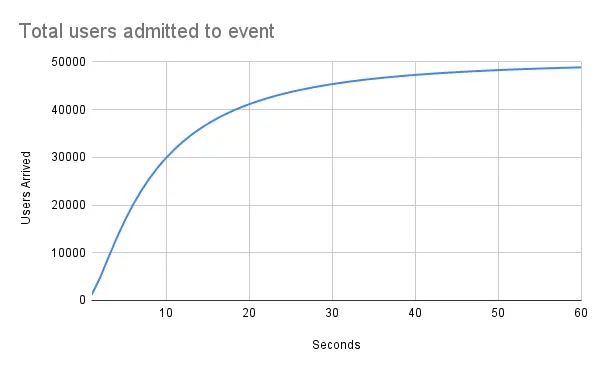Unscalable

All their faces were frozen for a few milliseconds too long. I had to check whether I was still connected to the internet.
Finally, one face spoke up: “They’re the fastest growing creator we’ve had on the platform ever”. A wave of nods swept down the screen.
Another chimed in with more concern: “It’d be incredible to host their livestream. But can we handle that many people coming to the platform at once? Have we ever tried it?”
That was our first meeting about scaling new livestreaming products. Smaller creators had been using live audio for a few weeks. Live video was poised to release. We were eager to get larger creators talking and interacting with their fans in real time.
Unfortunately, eagerness alone doesn’t make hosting live events a core competency. The company had been a payments processor for a long time—indeed, a demanding task—but one that can be done asynchronously in the background. Retrying a task doesn’t ruin the UX. Meanwhile, in a live event, requests are synchronous, and applying backpressure means 5XX errors and a broken experience.
Fortunately, though, we live in an age where competencies come packaged in a “Pro” or an “Enterprise” plan. We knew we couldn’t set up streaming on our own, so we decided to work with a vendor to stream audio and video to users and power chats.
However, despite lifting the burden of streaming all that data, our servers weren’t off the hook. The system still needed to authenticate arriving users, load data specific to them and to the event they were attending, and render the pages. The best streaming vendor in the world wouldn’t help if we couldn’t get users into the event in the first place.
So we still faced a problem: could our system support a thundering herd of users trying to get into an event? A small team of us was tasked with answering that question, and if the answer was no, trying to make it a yes within the quarter.
Asking the question
The first step in answering a question like that is to tighten it up. It’s not enough to ask “can we support this load?” — we have to quantify the load so we can compare it with the measurements taken of our system.
So what do we need to measure?
A system responding to synchronous requests has a certain amount of capacity available. This capacity is dictated primarily by the amount of CPU and memory available, but also by logical constraints in the application. For instance, a server with 8 CPU cores provisioned is only bottlenecked by the CPU if the logic actually allows all 8 cores to be utilized. If the server has a single instance of a single-threaded application running, CPU is no longer the constraint since 7 cores sit unused. Regardless of the constraint in question, the end result is that each server can only handle a certain number of requests at a time before it must start rejecting requests.
Naturally, we don’t want our system to reject requests. If it does, users will receive errors rather than the event page they were hoping to see. Those users might not bother with the event after that, meaning a smaller turnout for the creator hosting the event. Both the user and the creator suffer, which of course means the business suffers since it relies on those two parties to make any money. So to avoid a crummy outcome, the system must have sufficient capacity to respond to requests without dropping any.
Now, let’s rephrase ‘load’ in light of request capacity, given that it is our fundamental, measurable constraint.
At a high level, hosting a live event requires admitting users, responding to their various actions throughout the event, and streaming data to them in real-time. Thanks to our vendor, we didn’t need to worry about the latter two and could focus on admitting users to the event. To do that, we’d have to handle a handful of requests: rendering the page, refreshing an auth token, and registering the user with our vendor.
In a sense, we can think of a “user” as an abstraction over those initial requests; thus, our task became ensuring we had capacity for that set of requests for every user who arrived. Given this idea—that a user represents a bundle of requests—it started to seem like a simple calculation: figure out how many requests are required to admit a user and then multiply that by the number of users, right? That tells us the capacity we need to have on hand.
While that’s a fine way to calculate the absolute max capacity needed, it does neglect one facet of load, and that’s time. Users won’t arrive at precisely the same instant, which is what our previous calculation assumes. Instead, arrivals will likely follow a log-normal distribution, with the number of arrivals peaking around the times when notifications are sent out, then tapering afterward.
As an example, here’s how user arrivals might look if we assume 10,000 users are coming, a notification is sent just before the 2-minute mark, and the majority of users arrive within 5 minutes:


Factoring in arrival times is helpful because it shows that the max concurrent load is not 10,000 users times the number of requests made per user. Instead, the max is actually 80 users times the number of requests. That’s over two orders of magnitude less capacity we’d have to have on hand!
Of course, there’s still more nuance to add. We haven’t accounted for the fact that requests don’t resolve instantaneously. They can take hundreds of milliseconds, or even full seconds, to complete. That means our maximum required capacity is likely higher, but it’s hard to say by how much without latency measurements for the actual requests being made. This brings us to the next major step: obtaining concrete numbers for the user count, the anticipated arrival rate, and the latency distributions of the requests each user will make.
Getting concrete answers required a cross-team discovery meeting, since, like good software engineers, we’d buried them under layers of abstraction.
Engineers love abstraction. We abstract away circuits of transistors and call them logic gates. We abstract away groupings of logic gates and call them devices, like a multiplexor or adder. We combine devices into components like an ALU or control unit, and then promptly forget about those and call the whole thing a CPU. At a higher level, files combine into modules, and modules create components, and components make up services. These layers allow us to hold immense complexity in our heads without being overwhelmed. When the situation calls for it, we can dive into a specific layer without needing to recall all the details of the other layers.
Since abstraction allows us to let go of details, it’s essential to abstract the right things. If you try to hide two sets of details from each other that actually belong together, then your abstraction will slow you down. You incur cost every time you cross the abstraction boundary.
My favorite example of this is engineering teams. Do you group people around a particular system? A well-defined problem space? A particular technology? Do the teams need to move fast with full-stack autonomy? Or is one layer too complex, making a horizontal team the more efficient approach? Each team layout enables certain kinds of projects by removing complexity, yet slows down others.
At my company, we have a dedicated infrastructure team, frontend and backend platform teams, as well as various cross-functional product teams. In general, product teams sit at a higher layer than the infra and platform teams, so while they can control frontend and backend logic, they tend not to interact with the lower-level details of how the app is deployed and run. This places an abstraction boundary firmly between what we’re running and how we run it, which reduces cognitive load on both sides of the boundary.
However, when it comes to scalability—that being the ability to match or exceed the capacity required of the system at any given time—this product/infra abstraction boundary is abrading. As mentioned earlier, capacity can be a resource issue if CPU and memory are fully utilized. The infrastructure team can quickly address this issue by adding resources to existing servers or by adding more servers to the fleet. But what if it’s a logic issue? Worse yet, what if you don’t know what the problem is? Context needs to be passed across each of those team boundaries, and that takes time to get right. You’re playing a game of telephone with complex ideas expressed in domain-specific language.
And so, we set up a cross-team meeting to start playing telephone. All the key parties were represented: the product team working on live events, the infrastructure team, and the platform teams. We discussed the customer journey, the pages encountered along the journey, and the requests needed to load each page. We discussed the aspects of the experience that were our responsibility versus those of our vendor. We discussed the number of users to expect and how quickly they might arrive. Altogether, we determined:
- There would be about 50,000 users coming.
- Most would click through a link in a notification to get to the event page.
- While we would try to space notifications out over 10 minutes to stagger user arrivals, we wanted to play it safe and assume most would arrive within 1 minute.
- About 70% of traffic would be from iOS and Android, and 30% would be web. The API requests differed between mobile and web, so we compiled a list of both.
Finally, we had a well-defined version of the original “can we support the load?” question. The real question was: “Do we have capacity for 15,000 sets of web requests and 35,000 sets of mobile requests log-normally distributed over 60 seconds?”.
I plotted it out to find the peak number of users who would be arriving concurrently. The peak dictates our max capacity requirement. Here’s how it looks:

We expect most users will arrive around the time a notification is sent out, and then arrivals will tail off. The peak arrival rate is about 4200 users per second in this model.
Below is the cumulative sum of users in the event as a function of time. It’s the integral of the “Users arriving per second” graph above.

With the question well-defined, we were ready to start trying to answer it.
Struggling to answer
If you think back to high school science, you probably remember the terms accurate and precise. They’re terms that describe measuring tools, where ‘accurate’ means the measurements are close to reality, and ‘precise’ means the measurements are consistent if taken multiple times. For instance, a scale that weighs a 10-pound object at 8, 12, then 10 pounds might be considered accurate since the average is 10 pounds, but not very precise. Meanwhile, a scale that weighs it at 8 pounds every time is very precise, but not very accurate.
But what if your scale isn’t accurate or precise?
I jumped on a Zoom call with a colleague from the backend platform team to start building a load test simulating the live event. We hoped to get an answer to our well-defined question of capacity. With a list of the requests users would be making in hand, we began setting up a scenario that mimicked the “Users arriving per second” graph above. 30% of those users were hitting the web route for the live event page, and the other 70% were making the requests our mobile apps make. All users were going through our auth flow.
Before launching a full-blown test, I ran our scenario with a small amount of traffic to verify that it would work. Right away, I noticed that the traces being recorded in Datadog had durations that were double or triple what they usually were in production. Some requests took an order of magnitude more time than their production counterparts.
Puzzled by the poor accuracy, I figured I’d try the full scenario to verify that we had the traffic pattern correct. The request count climbed toward a peak, then… stopped completely? Maybe Datadog had stopped receiving traces? Perhaps the client sending requests had died for some reason? I tried it again, only to see the traffic climb at half the pace it did the first time, then tail off correctly. A third attempt yielded yet another curve. Even with the same machines and parameters, the test was yielding wildly different results. Now I was puzzled by the poor precision too!
I pored over our Terraform and our various configurations for the load test environment to figure out what was going on. The lack of accuracy was easy to find: the load test database was smaller than the production one, and many of the prod caching layers weren’t set up. A look at the database metrics also pointed out the precision problem. Load on the database fluctuated throughout the day, even when a test wasn’t running. This appeared to be due to background work that the app kicked off on its own.
From there, I dug into the load test framework. The docs didn’t solve my problems, but they did reveal a new one. They explained that the framework was not made to provide absolute figures for something like requests per second, which is exactly what I was after.
In fact, the load test framework didn’t allow direct control over the request rate at all. Instead, you configure users, who then make a set of requests in a defined order. This makes test writing intuitive, but also unpredictable because users only make their subsequent request once they’ve received a response. So request rate varies with response latency. That makes the actual number of requests per second highly variable in our inaccurate load test environment, making subsequent test runs imprecise.
Armed with that information, I turned back to the load test. For various technical reasons, adjusting the database and adding a caching layer were going to be too time-consuming to be worth it, so I had to accept the inaccuracy. On the bright side, all the inaccuracy was in the same direction: all requests were taking longer than they would in production. That meant that if I could get the load test environment to handle the traffic, it would provide even stronger assurance that it would work in prod.
To make test results repeatable, I made a couple of adjustments. I started running tests at times of day where the database load was low, and I added more clients to spread the requests out and avoid overloading the sending side. Satisfied with the improvements, I reran the scenario.
Leaning back from my screen, the tiny, chromatic graphs told me that database load hadn’t increased significantly. However, response times from the client perspective had edged up, maxing out at just over 5 seconds. The server itself wasn’t reporting many errors, but the clients were seeing almost as many 503 errors as they were successes. I mushed my forehead into my palms and tried to picture the request pathway.
If the client was seeing errors, but the server wasn’t reporting them, then that had to mean they were being dropped before reaching the server. We did have a proxy with a request queue in front of our servers. Could the requests be stuck there? I reviewed the metrics and confirmed my suspicion: requests were timing out of the queue after a 5-second threshold. But why were they sitting in the queue and not reaching the server?
A foray into some gnarly old Ansible suggested an answer: the server’s concurrent request capacity was embarrassingly low. Like the Lincoln Tunnel at rush hour, constriction coupled with traffic was leading to a jam.
Each server, equipped with 8 CPU cores and 32 GB of RAM, was running only 19 instances of our app across 19 processes. Of those 19, 2 were dedicated purely to health checks, so actually only 17 were responding to requests. Further, each process handled requests serially, meaning it couldn’t accept a new request until the current one finished, even if it was blocked waiting on IO. An 8-core, 32 GB server could only handle 17 requests at once, max.
This was rather unfortunate, since, at 17 requests max, we’d need 5,435 servers to handle our theoretical peak load of 4,200 users arriving. Mercifully, web users only need 3 requests to get into the event. However, mobile users need 30, and we expected about 70% of traffic to come from mobile devices. This meant that there were about 22 requests fired per user on average. With 4,200 users sending 22 requests, and 17 handled per server, this resulted in 5,435 servers.
You might be thinking, improving concurrent request capacity is a solved problem, right? Since the mid-2010s, coroutines have been first-class citizens in many languages. They allow tasks to be interleaved on the same thread with simple async/await syntax, which enables efficient use of the CPU as the runtime can pause one request during IO to work on others. It can do so even within a single thread, meaning thread count is no longer a limiting factor for the number of in-flight requests your app can have at once.
Thanks to these changes, concurrent capacity (in IO-bound environments) has increased by orders of magnitude across languages and ecosystems. Node.js with its event loop can interleave and work on north of 10k requests at once. And Actix Web, a Rust web framework, defaults to 25k connections per core using coroutines. That’s not to say that the dependencies (like the database) of that server will be able to handle all those requests. But the point is, even if the bottleneck now lies on the dependencies internal to the service, we live in a world where a single Rust server with 8 cores can theoretically service 200,000 requests at once. Meanwhile, our servers were configured to service 17.
Without improvements, we were going to have to increase our fleet size by an order of magnitude and then some. Granted, this still assumed that all requests were coming in instantaneously, and that they had to all be handled within a second before the next instantaneous burst of requests arrived.
In reality, many requests could resolve in less than a second, and we could also fall back on the proxy queue to buffer requests for up to 5 seconds. So we likely didn’t need a full 5000+ servers running. But it was still patently obvious from the load test that we didn’t have enough capacity, and we had to make some weighty decisions about how to increase it.
It was time to chat about options with the team.
Duct tape
One thing was becoming increasingly clear during our chat: we would have to focus on the performance of the application itself, rather than application-agnostic scalability measures.
It’s easy to confuse performance with scalability. The two are related, but not synonymous. You could have a scalable system that runs like a potato, or a blazingly performant app that can only ever handle one request at a time.
At its core, scaling is all about throwing more compute at a set of operations. This is why the industry has shifted to stateless, containerized web applications—we want to be able to spin up the same code across as many CPUs as possible and balance requests across all of them.
Meanwhile, improving performance is all about throwing fewer operations at your compute. For instance, why are many Python libraries written in C under the hood? Because by dumping the interpreter and dynamic typing overhead, you can get the same functionality for a fraction of the CPU cycles, and therefore a fraction of the time.
The two work together, though. If scalability is about having capacity for necessary operations, and performance is about reducing the operations necessary, then it’s fair to say that a performant system will scale better. The “slope” is smaller in a performant system. So your best bet is to focus on performance if your architecture limits your scalability.
In our case, our architecture proved to be a cascade of limits. Handling requests concurrently within a process was out of the question, due to an outdated framework and mutable, global state. We either needed more servers, or more app instances per server running in their own process. A little more testing revealed we wouldn’t be able to squeeze more app instances into a server without increasing the provisioned memory, since we weren’t garbage collecting thanks to the devastating effect it has on performance. But increasing memory per server also wasn’t an option since it would cause us to binpack less efficiently and therefore spend more money on idle compute. So we probably just needed to add more servers.
However, each new server posed a threat to our dependencies and deploy process. One more server meant 19 additional app instances, which in turn meant 19 new connections to the database, Redis, and other dependencies. And to add insult to injury, the app had only one database and one caching cluster, so all writes had to go to the same primary instances. They could only handle so many connections before they would tap out.
Even before this project started, we’d seen issues during deployments. Too many new connections were created at once—and too many existing connections were still open thanks to our blue/green deployment style—and it would cause errors. The solution had been to slow down deployments. Adding more app instances was going to exacerbate the problem and force us to slow down more.
After some back and forth, we decided to increase the max number of servers by 75. We traded off between adding capacity and increasing deploy time, and figured we could settle for a slight increase in deploy time. Plus, if the servers weren’t being actively used during a deployment, we wouldn’t incur the deployment time hit anyway. It’d only be if we were actively scaled up. However, adding 75 still wasn’t quite the projected 5,435 servers.
Stymied by our system architecture, we had no choice but to turn to performance. Thanks to our regular cross-team meetings, some angles of approach were already mapped out, and colleagues were ready to make it happen.
Web duct tape
The first place we optimized was the chat page, which was the entry point to a live event for web users. After rendering, our vendor was able to take over the streaming operations; however, the initial render relied entirely on our services. Since every web user passed through the page, it was paramount that it render as quickly as possible to free up server capacity.
One of our experienced web performance engineers tackled speeding up this page. He started by analyzing performance data for the page in Datadog. It had been running in production for some time, so there was ample trace data to review. He examined the slowest traces and noticed a pattern: the slowest renders were over-fetching “bootstrap” data (data common to all pages).
He took a look at the bootstrap data to see what parts were relevant to the chats page. As frequently happens when dependencies are over-generalized, there was much in there that wasn’t relevant to the chats page at all. He added a few simple flags to the bootstrap code to selectively disable default fields, allowing the app to skip database queries and ultimately serialize a smaller payload. He turned the flags off just for the chats page, keeping our risk of bugs on other pages low.
Over a couple of iterations he took P50 latencies from ~380ms down to ~190ms (about a 50% improvement), and P90 latencies from ~700ms to ~300ms (a 57% improvement).
Mobile duct tape
The next major set of optimizations needed to occur in our mobile applications. We expected most users to enter the app through a push notification and that it would be a cold launch, meaning the app would make around 30 requests to fetch all the necessary data. That was about 30 too many.
Reducing request count would be tricky, since it meant less information to populate the UI. The team agreed on a 2-pronged approach: a quick, naive implementation that shut off all non-essential requests for the short term, and a more sustainable app launch system that ranked and executed requests by priority for the long term.
For the naive implementation, we were able to turn off much of the preloading the app was doing. Modern apps with a tab navigation preload data in the other tabs to make navigation snappy. So, if you launch the app from the home tab, it’ll also load the others simultaneously. However, since we were in a pinch, and a fully-degraded experience seemed worse than simply a slow one, we opted to stop preloading the other tabs. We’d load the chat room needed for the live event, and that was it.
For the longer-term approach, we considered delaying non-essential requests rather than outright abandoning them. The highest-priority requests were those needed to load the initial screens. But requests for data for adjacent screens or supplementary content, such as notification counts, could be delayed until after the initial screen was rendered. We implemented a request queue to space the requests out and smooth the load on the backend.
Altogether, we reduced the mobile app’s requests from 30 on launch to 16.
Results
As the quarter drew to a close, I looked back and realized we’d accomplished nothing of lasting significance.
With the performance improvements, we could admit 1,200 users per second fully scaled up—a far cry from the 4,200 I projected we’d need. Leadership decided that was fine, though, because we could bank on users arriving slower than I’d modeled. Personally, I decided it was fine because I doubted we’d see 50k users trying to join an event in the first place.
However, performance improvements without architectural changes are guaranteed to wear off over time and with enough entropy. This work was completed about a year ago, and I wrote the initial draft of this article about three quarters ago. Since then, the entry point for live events has changed. It’s no longer the chats page, and many of the requests being made to our backend now are different. All the work to optimize chat page rendering and reduce request counts made for a nicer chat experience, but was wasted effort in handling the thundering herd.
Also, as of the time of this writing, there hasn’t been an event with 50k users. The big one we expected was paused indefinitely because the creator said a no-no on social media and got socially exiled. We did have an event with about 1,200 folks in it recently, and it was kind of a bop! But even then we had browser tabs crashing and phones overheating. Looks like Enterprise packages can only do so much for your competencies. But hey, the backend was fine!
How did it go so wrong?
The core issue is that our company is structured poorly. By separating the product and foundations teams, we separate what code is running from how it’s being run. That makes it very hard to build independently deployable and scalable components, since each side wants to simplify to the interface of the other. The infra team created infra to run one code blob, and the product teams wrote one code blob to run on the provided infra. Teams are not empowered to provision the infrastructure they need themselves, so it’s always easier to shove new code into the existing blob than it is to throw a ticket over the wall to the infra team. This is the homomorphic force—the tendency of a system to mirror the system it’s being built in—in action.
Could the existing structure work better? Sure. Many companies have foundations teams. But rather than provisioning infrastructure directly, well-used foundations teams provide tools and libraries for product teams to use, like building blocks. Or they provide APIs to the platforms they’re building. They also help route alerts and pages to the appropriate product teams, to bring reliability and scalability concerns to the folks building the product. When combined, these building blocks, APIs, and alerts give teams the autonomy and accountability needed to create reliable, scalable, and delightful products.
However, as it stands, there is no autonomy or accountability, and ownership is wildly diffuse since the entire product is one big blob. Who should work to improve the concurrent request capacity of our servers? Is that a foundations issue since those are the teams forced to throw more servers at the problem? Or is it a product issue since those are the teams that actually work on the application code handling requests? Even if we could decide who should own it and do it, the changes affect the whole company since the whole company relies on the same server config. The blast radius is enormous. Who tests all the nooks and crannies of the app? Who signs off on it? Trying to make change without actual ownership dooms you to do a quarter of work and produce no lasting results.
This is the second time I’ve had to deal with a web app receiving thundering herds of traffic. The first time my team had complete autonomy and authority to change the app as we wanted. It was its own service, and not part of a monolith shared with the rest of the company, so our changes didn’t put other teams at risk. Importantly, other teams didn’t hinder us with their bureaucracy. We were solely responsible for making it happen, with support and guidance available from principal engineers if needed. We weren’t saddled by gigantic shared dependencies, like a single database or cache cluster. We could deploy independently.
That scalability work went incredibly well; we were able to handle over 100,000 users arriving at an event without any hiccups. We were running five 8-core Rust servers for the backend API, one 4-core Rust worker to handle background tasks, and hosting the frontend server-free with S3 and a CDN. That was a full architectural refactor that has persisted past my time at the company. Meanwhile, this scalability work languishes with a system that can’t handle half that traffic yet requires 100 times as many 8-core servers.
The difference in outcomes is not a coincidence. One company decoupled its applications and gave teams the autonomy and authority needed to be fully accountable to their goals and targets. The other company has a monolith and can’t articulate specific goals, other than variations of “don’t break the code”. As a result, solutions are prescriptive and principals micromanage implementation details, leaving little time to come up with a strategy out of the mire.
I am optimistic though. Many folks across engineering felt the pain of this project; pain stemming mainly from the way we work and write code. Feeling the pain is the first step in addressing it. To scale with our traffic, we need to learn how to scale with our codebase, our number of products, and our engineering headcount. I’m hopeful our next scalability project will be less about engineering a scalable application, and more about engineering a scalable organization.
